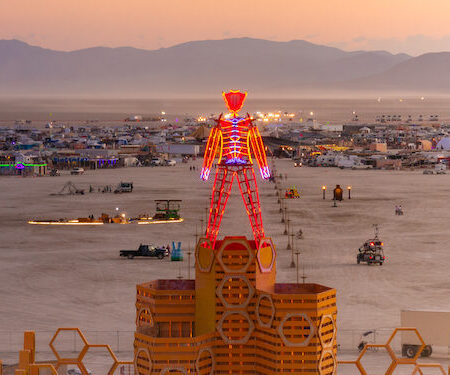(image credit: getty images)
Burning Man, the iconic festival that transforms the Nevada desert into a vibrant playground of art and community, is experiencing an unexpected dip in ticket sales this year. Once renowned for its sell-out crowds and elaborate celebrations, this year’s festival is confronting a reality check. For the first time since 2011, tickets are available without preregistration, and the resale market is flooded with bargains, offering tickets at less than half the regular price.
So, what’s behind this uncharacteristic slump? The reasons are as varied as the festival’s eclectic offerings, blending weather woes, economic pressures, and shifting cultural dynamics.
Weather Woes and Economic Pressures
Let’s start with the weather. If you’ve ever thought that desert festivals should be immune to the caprices of Mother Nature, think again. Last year’s festival was plagued by record-breaking heat and torrential rains that turned the site into a mud pit. The aftermath? Attendees faced the arduous task of salvaging soaked belongings and braving uncomfortable conditions. Over 70,000 festival-goers were stranded due to heavy rain and shelter-in-place orders. For many, the thought of repeating this ordeal in 2024 seems less appealing.
The extreme weather conditions of previous years have significantly impacted attendance. The combination of oppressive heat and heavy rains created a challenging environment, leading many to reconsider participating in future events.
But it’s not just the weather that’s causing concern. The economic landscape also plays a significant role. With Burning Man tickets priced at a hefty $575 this year and additional costs like parking, camp fees, and travel expenses potentially pushing the total to $8,000, the festival is becoming increasingly inaccessible. Recent layoffs in the tech industry compound this financial burden—a sector that has heavily populated the festival in recent years. As tech workers face job uncertainties, their disposable income for such extravagant events shrinks, contributing to the decline in ticket sales.

(David Crane/Picture Alliance via Getty Images)
A Changing Culture
Beyond the external factors of weather and economics, an internal shift is also turning heads. Burning Man has evolved significantly since its humble beginnings in San Francisco’s Baker Beach in the 1980s. What started as a grassroots celebration of art and community has now seen a rise in what some consider “concierge camping”—luxurious, pre-set camps where attendees pay for high-end amenities rather than contributing to the festival’s community ethos.
This shift towards opulent accommodations has changed the festival’s dynamic, with many long-time attendees lamenting the loss of the original spirit of participation and self-reliance that once defined Burning Man. The prevalence of these high-end setups contrasts sharply with the event’s foundational principles of community contribution and collaborative effort, creating a cultural rift among attendees.
The Broader Festival Landscape
Burning Man’s struggles are not occurring in isolation. The broader festival landscape has also seen a decline in ticket sales. Major events like Coachella and Lollapalooza are experiencing similar issues, with many festivals grappling with sluggish sales. Economic factors, such as rising costs and financial uncertainties, are likely contributing to this trend across the board.
In summary, Burning Man’s current ticket sales slump reflects a convergence of factors: extreme weather, economic strain, and evolving cultural dynamics. As the festival grapples with these challenges, it remains to be seen how it will adapt and whether it can reclaim its former magic. For now, the once-mystical allure of Burning Man is facing its most significant test in over a decade.


